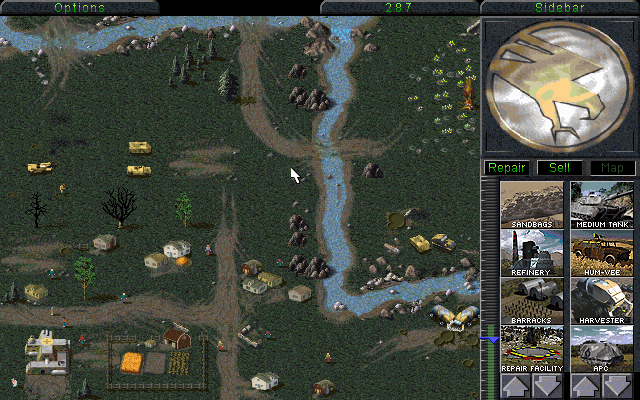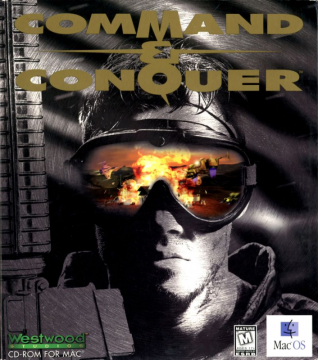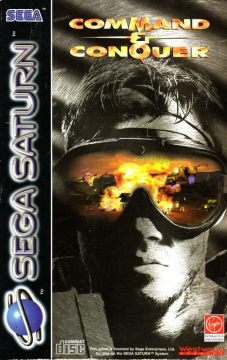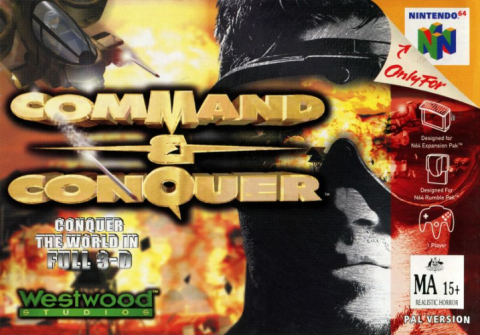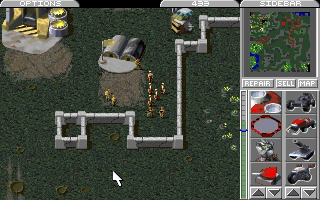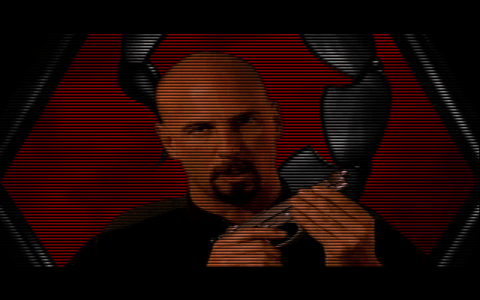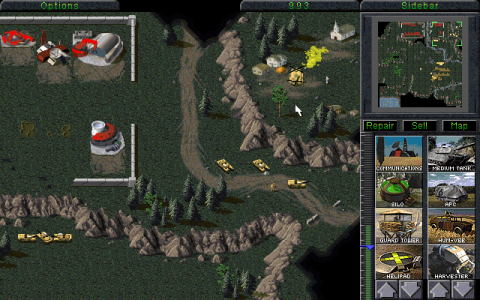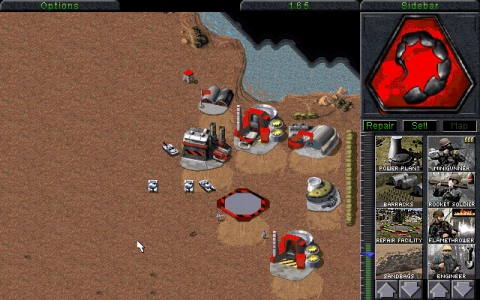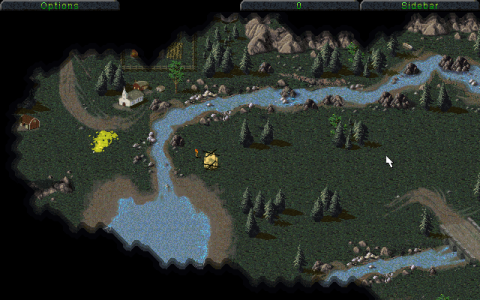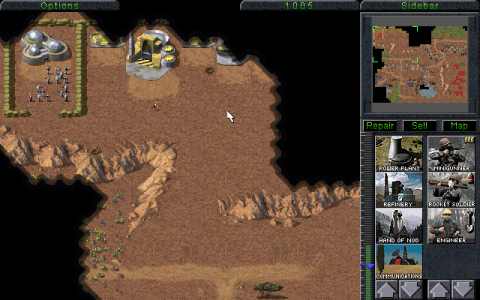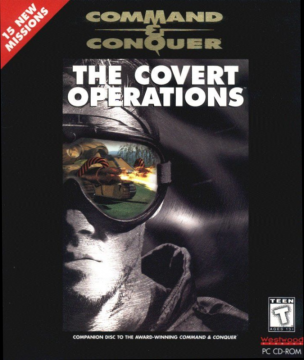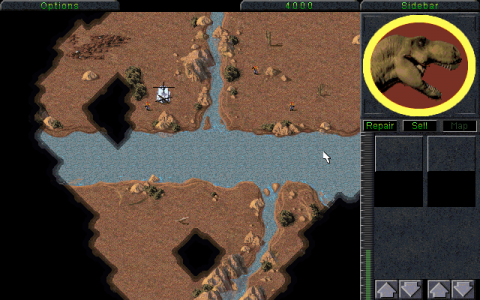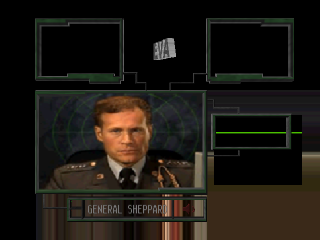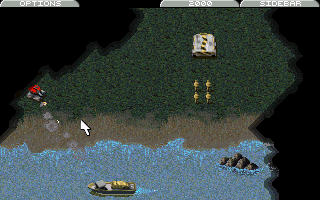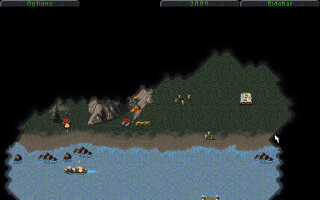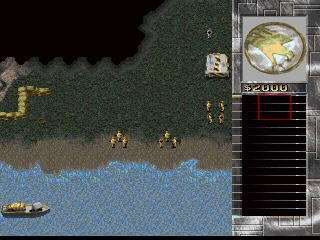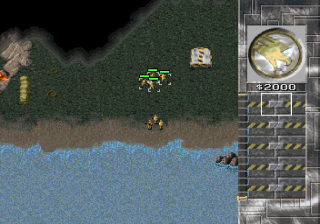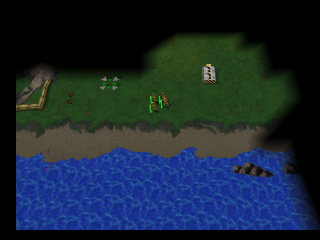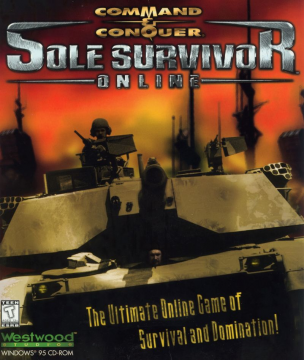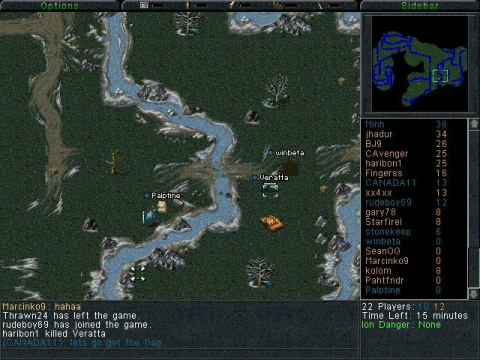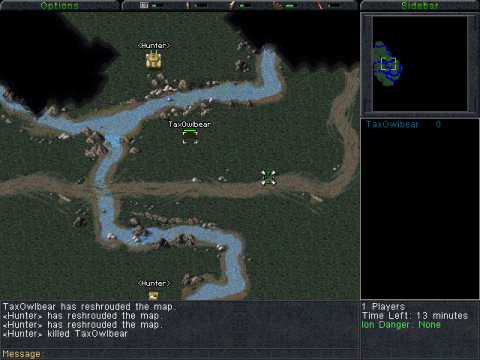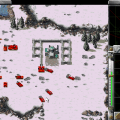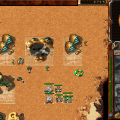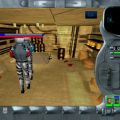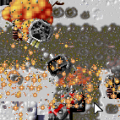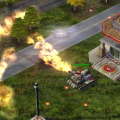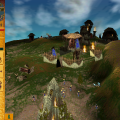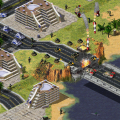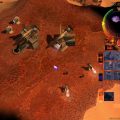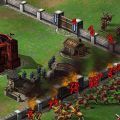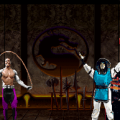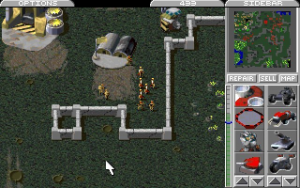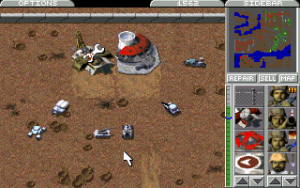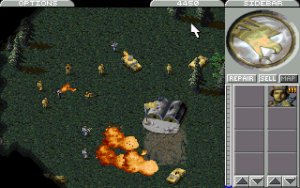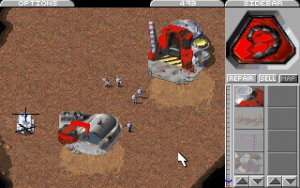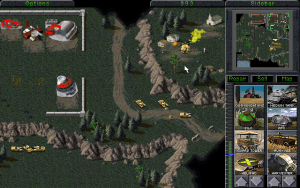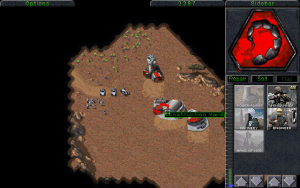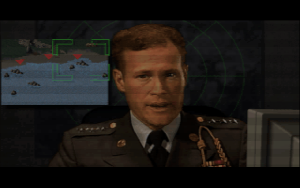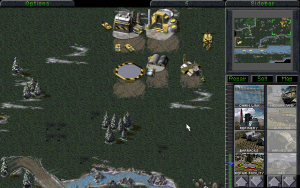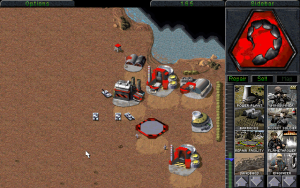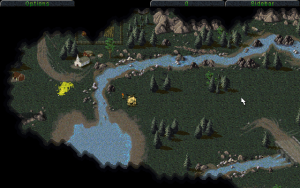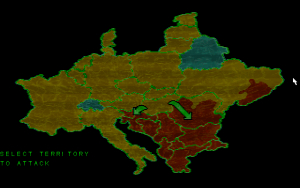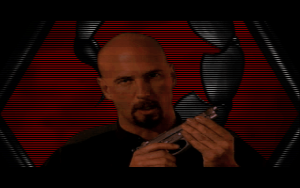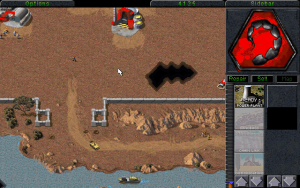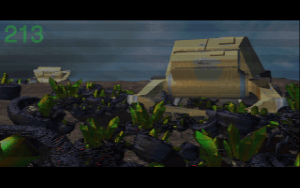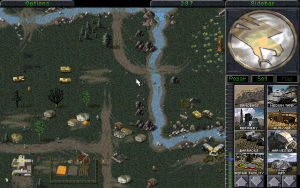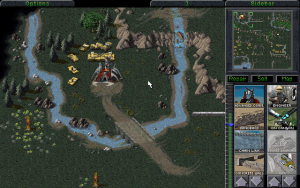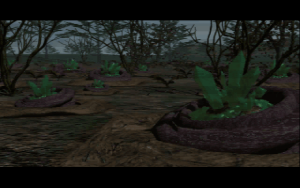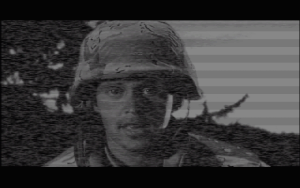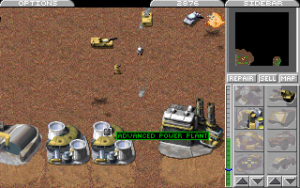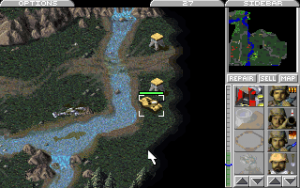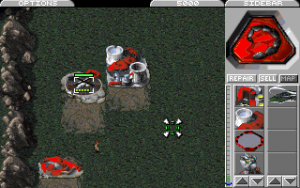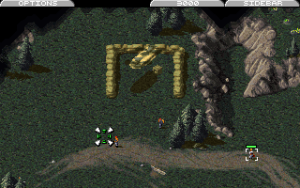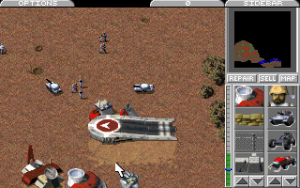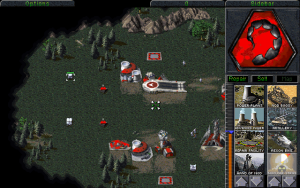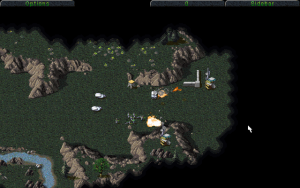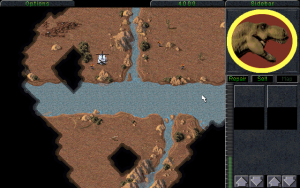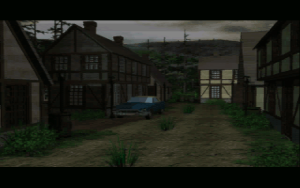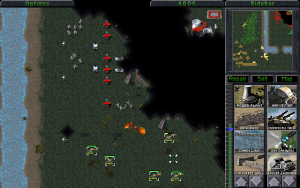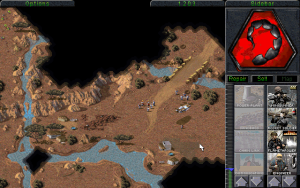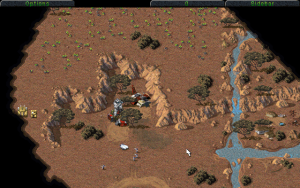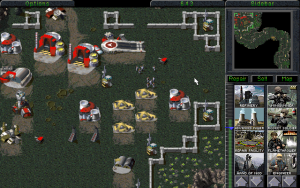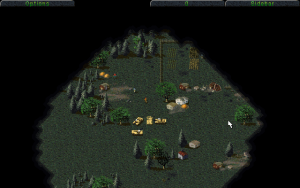- Command and Conquer
- Command and Conquer: Red Alert
- Command and Conquer: Tiberian Sun
- Command and Conquer: Renegade
- Command and Conquer: Red Alert 2
- Command and Conquer Generals
- Command and Conquer 3: Tiberium Wars
- Command and Conquer: Red Alert 3
- Command and Conquer 4: Tiberian Twilight
- Command & Conquer: Generals: Combat Cards
- Command & Conquer 3: Tiberium Wars (Mobile)
- Command & Conquer: Red Alert Mobile
- Command & Conquer: Red Alert (iOS)
- Command & Conquer 4: Tiberian Twilight (Mobile)
- Command & Conquer: Tiberium Alliances
- Red Alert OL
Westwood Studio’s Command and Conquer is one of the most important games in the 1990s computer game landscape. To understand the game and its significance, one need only to turn the clock back to the early 1990s. Westwood – founded in 1985 and acquired by Virgin Games (later, Virgin Interactive) seven years later – had already gained a solid reputation, having worked on RPGs such as DragonStrike in and the first two Eye of the Beholder titles, to name a few. Its release of Dune II: The Building of a Dynasty in 1992, however, would bring it lasting fame in the history books. Inspired by and building upon gameplay mechanics introduced in the Genesis game Herzog Zwei (made in 1989 by Technosoft), the developers codified the foundations of RTS as it’s known today, such as mouse-and-keyboard controls and base building. But rather than rest on their laurels, as Westwood co-founder Brett Sperry recounted in a 2001 Gamespot feature by Bruce Geyrk, “it was time to build the ultimate RTS without the ‘leg up’ from a license like Dune.” The budding project was originally planned to be a high fantasy affair, similar to what a then-newly christened Blizzard Entertainment was conceiving, with 1994’s Warcraft: Orcs and Humans being the end product. Inspired by the Gulf War, the socio-political climate at the time and various other ideas, however, it soon followed down a path that was unique for a strategy title.
The ensuing result, after over two years of work, was Command and Conquer – to this day known by its working title, Tiberian Dawn – which was released on September 1995 for the PC (MS-DOS), with a Macintosh port (done by Totally Hip Studios) released on December 1996 and a Windows 95 edition (known as Command and Conquer: Gold) coming out on March of the following year. Even with the pedigree set by Dune II, it was an ambitious yet risky venture. Albeit, one that would not only surpass its predecessors but set the stage for things to come.
The story starts off in 1995, when a meteor lands near the Tiber River in Italy, bringing with it a strange crystalline material called “Tiberium” that soon becomes an immensely valuable resource. That same year, however, a militant, cult-like organization calling itself the Brotherhood of Nod reveals itself to the public, led by an even more enigmatic figure known only as Kane. Through propaganda, terrorist attacks, front companies and seizing a virtual monopoly over the growing Tiberium deposits, almost overnight it becomes a superpower in all but name with more insidious plans for the world. In response to the threat posed by Kane’s minions, the United Nations formally activates the Global Defense Initiative (or GDI), a multinational peacekeeping force tasked with stopping terrorism, and Nod in particular. Fast forward to the then not too distant future of the late 1990s. What starts out as covert skirmishes between GDI and Nod quickly escalate into a global conflict known as the First Tiberium War, fought with conventional arms and experimental weapons. All the while, the very substance that sparked this turn of events begins reshaping the face of the planet, and Kane puts into motion a plan that could change human history forever.
Said conflict plays out over the course of two campaigns, covering each faction. With a total of 37 missions (21 for GDI and 16 for Nod) available, you play as a commander serving either side and trying to win the war, the campaigns quickly diverging into separate plotlines and endings; the Nod outcomes in particular, though generally the same, lets you choose what scene plays at the end. While starting off easy enough, many subsequent missions ramp up in difficulty and can range from sabotage and rescue missions with a limited number of troops (if not just one unit) to you having limited time and/or resources at hand before the enemy strikes. Combined with small scripted touches (such as reinforcements arriving into the battlefield) and hidden bonuses found by exploring the map such as supply crates, these provide a degree of variety and replayability; as an added touch, the game also provides a timer, statistics measuring performance and even score at the end of each mission, providing more incentive to do better. But instead of simply jumping into the action immediately, there’s an overhead campaign map of each distinct theater (Europe for GDI and Africa for Nod) which, though starting off linear, at points let you choose which country to target and thus the next mission; certain missions are only available if you select the appropriate territory (or in the case of one GDI mission, fail to destroy the right building).
Although this usually means little more than changing the palette of the battlefield map or at best, specific objectives, it also adds a degree of replayability while giving you the impression of being able to alter the outcome, however slightly. Conveying the plot in between missions, meanwhile, are various briefings and footage (less than an hour’s worth of material overall) made up of CG cutscenes and fully-voiced FMV, a substantial leap from Dune II due to the advent of the CD-ROM and previous strategy game titles in general. These feature a number of characters such as Gen. Mark Sheppard (played by Eric Martin) and Dr. Ignatio Mobius (Richard Smith) for GDI, with Nod featuring Seth (Eric Gooch) and for the first time, introducing the infamous Kane himself (Joseph Kucan). Rather than have said cutscenes be only straightforward exposition for the next levels, however, these have a good portion of the cast addressing you directly as if you’re part of the story – a consequence of the Electronic Video Agent (EVA), a framing device that in-universe, allows you to command and access information in real time – along with a few twists and turns that help make events more interesting, adding a bit more humanity to both the “good guy” GDI and the villainous Brotherhood in the process. Kane shooting a would-be nuisance in Nod mid-briefing is but a taste of what to expect.
Gameplay-wise, Tiberian Dawn goes further than just rehashing Dune II, instead using the opportunity to refine and feature mechanics that would lay down the foundations for the Command and Conquer experience. With the Mobile Construction Vehicle or MCV (a special unit that unfurls into your main HQ and makes placing insta-built structures on the map possible) in place of standard workers, base building is made both intuitive enough for even non-strategy gamers to understand and necessary for long-term survival; power plants, for instance, are needed to energize your growing base and defensive towers to protect it, while setting up Airstrips or Weapons Factories provides access to vehicles and tanks. In order to sustain your base’s economy, there are Harvester vehicles that automatically collect Tiberium and refinery structures (which come with a free Harvester) at your disposal, making resource gathering less of a concern compared to fighting the enemy.
Reconnaissance of the battlefield and lifting the fog of war (which permanently keeps the explored sectors visible), meanwhile, are emphasized as well, be it for finding hidden bonuses or spotting foes before they do the same. In terms of combat, while there is a general rock-paper-scissor dynamic present – such as Rocket Soldiers being able to take on vehicles with ease, though are particularly vulnerable to Grenadiers and flame-based weapons – there’s a level of fluidity in the action that, along with logical soft counters (like tanks being able to simply run over infantry despite doing minimal damage with their actual attacks) and the lack of an actual unit cap, prevents any single clash from being stale; coincidentally, this also helped birth the infamous “tank rush” well before Starcraft popularized the concept of the “Zerg Rush,” among others. Which isn’t getting to the possibilities opened by the use of Engineers (non-combat support infantry that can capture enemy buildings and repair your own) and Commandoes (special forces operatives that can insta-kill infantry and wreak havoc on bases behind enemy lines).
All this is made manageable through a vertical sidebar interface on the right side of the screen. Through this, you have convenient access to a minimap (provided a radar building is present), credit counter, power meter and construction/production lists for structures and units in one place (given the appropriate requirements), along with the ability to repair damaged buildings and sell them for additional income; all this is achieved in real time without breaking away from the wider battlefield. Combined with being able to select and attack just by left-clicking the mouse, the resulting action is recognizable, albeit in a basic sense, to more contemporary RTS aficionados and long-time fans alike.
The game also introduces two of the most notable factions in the RTS genre: the Global Defense Initiative (GDI) and the Brotherhood of Nod (often just referred to as Nod). While both share many of the same aesthetics, units and structures in Tiberian Dawn (barring exceptions like the distinctive Hand of Nod barracks and laser-equipped Obelisk of Light) to the point of having very similar tech trees, even at this point in time, it’s evident that their differences aren’t cosmetic. GDI (colored yellow/gold), for instance, relies mainly on conventional arms and heavy firepower to win the day, reflecting its in-universe professional military background and backing by the United Nations; this can be seen in their unique ORCA Assault Craft, greater and the potent, double-barreled Mammoth Tank. While Nod (colored red), befitting its villainous, subversive nature and control over the black market, prefers hit-and-run tactics to make up for its somewhat weaker arsenal and isn’t afraid to get its hands dirty; these are reflected in their use of swift Recon Bikes, access to flamethrowers and toxins; its willingness to go beyond ethical or moral standards can similarly be seen on a reliance on more experimental fare like Stealth Tanks. Adding in each side’s respective superweapons (be it GDI’s Ion Cannon or the nuclear warhead-equipped Temple of Nod), and what you end up with is a pair of distinct sides that, even with their own preferred play styles, are balanced and flexible enough to not be stale. All the while blending well into the overall backdrop of its alternate reality.
Then there’s Tiberium itself, which is more than just the main in-game resource. Inspired by the 1957 film The Monolith Monsters and the Spice Melange from Dune II, the strange substance is just as much a central element in the setting as Kane is. Over the course of the campaigns alone, not only do you discover some of its peculiar properties – thanks in no small part to Westwood going to the trouble of including details like its chemical composition – but also realize that it’s growing more extensive to the point of contaminating (if not altering) the surrounding environment. Yet though cutscenes showing human casualties from Tiberium poisoning or plants mutating to further spread the resource come up, it’s also shown how increasingly valuable it is to civilization, be it for scientific and economic reasons or (in the case of Nod) more esoteric purposes. Even in the thick of the action, this is highlighted in infantry units being poisoned and killed if exposed to those deposits or how more than a few battles tend to be over securing them, especially once the ones close to your starting position “dry up.” Beyond simply providing a central thematic anchor, it’s not too farfetched to perceive its significance as a subtle commentary on conflicts throughout history over a limited resource symbolizing power. Whichever way it’s spun, it certainly puts Dr. Mobius talking about how “the possibilities of Tiberium…are limitless!” in a deeper light.
On that note, it’s fair to say that one of very first things that catches one’s attention in Tiberian Dawn is the setting; as early as the rather creative installation screen (presented as your EVA coming online), it doesn’t waste time establishing its tone. Compared other strategy titles in the early-mid 1990s, the game possesses a cinematic yet weighty flare that didn’t really exist in strategy gaming until then, barring perhaps Blizzard’s Warcraft. And unlike the highly futuristic sci-fi bent of Dune II, the game’s premise also takes much inspiration from the then-contemporary socio-political landscape, notably defined by the Gulf War, the end of the Soviet Union, and the growing turmoil in Yugoslavia; this can also be seen in the sly jabs at the media, such as Nod staging news broadcasts to manipulate public opinion or GDI’s seeming dependence on good PR. As Westwood co-founder Louis Castle remarked in an interview, “We wanted to make it a contemporary war for a contemporary world, with contemporary politics” albeit in an alternate universe “to avoid dealing with the sobering issues of a real war;” Brett Sperry’s views during those days on how future conflicts wouldn’t be between nations but between the civilized, “developed” world and anarchic or terrorist movements – which, to some degree, was not too far off the mark in light of organizations like Al Qaeda and ISIS – coincidentally shaped the choice of factions.
This is blended with other influences to establish a unique premise with a flair of mystery that didn’t quite exist in the genre before, from its use of experimental yet still “realistic” sci-fi technologies (like lasers and VTOL aircraft) to the downplayed yet noticeably esoteric undertones in Nod (down to its name being a Biblical reference) and the implications that Kane may or may not be the same Cain from the Book of Genesis. The CG cutscenes and FMVs, made possible thanks to storage advances in CD-ROMs, drive this even further. Granted, they come across as cheesy and at points, amateurish – with a good portion of the cast being either small-time actors or in-house Westwood staff, with Kucan originally the developers’ audio director – which are made more apparent by the low budget, as many scenes tend involve a few people sitting or standing in front of a green screen. Nonetheless, when put together they manage to convey the seriousness of it all without being too overbearing. All while, before your eyes, laying down the groundwork of what would become a long-running saga.
This isn’t to discount the visuals and audio, which help considerably in giving the game its atmosphere. Utilizing 2D VGA graphics – moved to SVGA resolution from the Macintosh and Gold editions onward, though this only really zooms out the camera and cleans up the interface – Tiberian Dawn is a decisive step up from Westwood’s previous strategy fare. Rather than the stylized top-down and comparatively restrictive view of the battlefield in Dune II, there’s decisively more in the way of map sizes, environmental textures (be it African coastlines or European terrain) and detail on both structures and vehicles alike, to name a few; buildings in particular not only visibly assemble themselves upon being constructed, but similarly show visible damage when attacked before being destroyed. Although unit sprites aren’t too proportional (the “infantry taller than most vehicles” perception becoming something of a tradition itself), are well animated, giving them fluid motion not really seen in RTS at the time. When combined with various effects – like explosions, smoke and missiles streaking mid-flight – these add life and a certain dynamism into each battle.
At the same time, though, the prevailing art style and architecture (including the more fanciful elements like the Obelisk of Light) are noticeably conventional if not somewhat muted, befitting the near-future timeframe; even the way infantry can be blown up to pieces by myriad munitions or how vehicles explode help in driving home the grounded nature of modern warfare. On top of solid and suitably meaty sound effects, these are complemented by Frank Klepacki’s soundtrack. The mix of rock, industrial and military motifs found throughout (which have since come to define Klepacki’s musical signature) not only blend well with the on-screen carnage – simultaneously heart-pumping, heavy and ominous – but really sticks with you long after the game ends, setting a benchmark for later entries in the franchise to follow. The opening level theme alone, “Act on Instinct”, is about as memorable now as “Hell March” for the Red Alert series.
Not everything, however, is smooth sailing with Tiberian Dawn, in part due to the passing of time. Unless you have the edition that’s part of EA’s Command and Conquer compilations such as The First Decade (which is the same as the freeware release) or fan-made patches and projects, getting the original game to work in modern systems can be a challenge; by virtue of being so old that it’s barely compatible with more recent PC builds, without said editions, online patches or other workarounds, you may wind up more frustrated than anything else. This extends to the limitations made more apparent by hindsight. For one, there’s no skirmish mode of any kind, with the exception of multiplayer for up to four players through the long-defunct Westwood Chat client of Westwood Online (introduced in the Mac port and Gold Edition). You could only select a limited number of troops at any one time with your mouse, while the more intuitive aspects of the game interface (from querying commands to control groups) have yet to appear; other mechanics and elements, such as naval units (outside of campaign missions), neutral tech buildings and garrisonable structures are also entirely absent. The graphics themselves haven’t aged so gracefully, be it the limited texture palette, low resolution, the inability to render urban landscapes (outside of small villages) or infantry coming across more like pixelated blobs. This isn’t to ignore the issues that were already present back then, including the somewhat sharp difficulty curve, inconsistent AI and pathfinding – such as Harvesters not always going to where they’re supposed to go, or enemies being scripted to the point of being predictable – and as at least one critic at the time noted, how some campaign missions tended to be more like puzzles with only one preset solution.
Those said, neither flaws nor hindsight fail to diminish the game’s strengths and high points. Upon release, Tiberian Dawn proved to be a commercial windfall. On October 1995 alone, according to PC Data, it was the fourth best-selling CD-ROM product in the United States; by September 1996, Westwood reported sales of over one million copies worldwide, which only grew in the months after. It also received multiple accolades from critics and media outlets, praising not just the fast pace, intuitive controls, distinctive story and solid gameplay. Which to say nothing of, among others, winning PC Gamer’s “Best Strategy Game” award for 1995 as well as the Gold edition being nominated for “Computer Strategy Game of the Year” at Academy of Interactive Arts and Sciences’ first Interactive Achievement Awards in 1998. It comes as little surprise then, that Command and Conquer would wind up in “Top 10” lists and similar articles in the years after, even well into the 21st Century.
But more than just sales, awards or being a significant technical leap from Dune II, Tiberian Dawn also left a lasting impression among gamers and developers alike. Whether it’s the fluid action, base building, graphics or the deceptively simple interface, newcomers were introduced to RTS with this game, and shown the potential the burgeoning genre had to offer. The setting and lore (from GDI and Nod to Tiberium and Kane) also earned more than a few fans for how distinctive they were and how much room there was for more; indeed, many of the nigh signature elements, such as the Mammoth Tanks and Obelisk of Light, would (in one way or another) become recurring mainstays in subsequent sequels and spinoffs. As taken for granted as standard RTS conventions may be nowadays, it’s no exaggeration to suggest that the foundations lain have not only spawned one of the classic franchises in RTS, but also ensured Command and Conquer’s place in gaming history by helping open the proverbial floodgates; even in works as varied as Creative Assembly’s Total War series and even Blizzard’s Starcraft II, you could still see elements and mechanics that were clearly borrowed from Westwood’s work. That it remains remarkably playable after over 20 years, let alone is still remembered at all, is a testament to all that risk paying off.
With all the acclaim, however, this was only the beginning of far greater heights.
Command and Conquer: The Covert Operations
With the success of Tiberian Dawn, it’s almost a certainty that there would be an expansion pack made to capitalize the momentum. True enough, Westwood was already at work on just that. Thus, on April 1996, Command and Conquer: The Covert Operations was released for MS-DOS, with a Windows 95 version launched around the same time as the Gold edition. It may have been one project out of many that had been finished by then, among other works in progress at the time being a planned prequel that would be known as Red Alert 1. But all the same, what came out met gamers’ expectations.
Unlike most subsequent expansions in the franchise, The Covert Operations is one in the most direct, technical sense of the term. As is typical of that era, there are no significant gameplay features or options introduced; in fact, there are almost no new FMVs or CG cutscenes to be found at all. Rather, its biggest selling point is 15 new missions (seven for GDI and eight for Nod) set around the First Tiberium War. In lieu of a main campaign mode, you can also play these at any time through a list, and in any order to boot. This isn’t to say that there’s no effort put, as though said missions only have text briefings, they present the same degree of quality and variety as elsewhere seen in Tiberian Dawn, while also featuring units (like Nod’s Chem Trooper) that were more seen in multiplayer. If anything, these tend to be even more difficult – whether it’s defending a Nod base against seemingly impossible odds, or as GDI, surviving an enemy infiltration of your base while fending off attacks – as though the developers assumed you had finished the base game. With the added longevity and challenge provided, these also make up for the lack of a proper skirmish mode.
Westwood, however, slipped in a hidden gem as well. That being five, non-canon “Jurassic Park” missions (also known as the “Funpark” missions), which involve dinosaurs in one way or another. Accessing this mini-campaign of sorts involves starting the game with the “funpark” command-line argument activated, after which point selecting either faction triggers a brief FMV cutscene featuring Kane himself casually ordering you to investigate “strange animal behavior.” Although rife with issues – which include a bug in the fourth mission that grants access to both sides’ arsenals, and an “invisibility logic” (tied to the dinosaurs’ walking animation) that made finishing some others difficult – the challenge as well as the idea of not just fighting dinosaurs but also play as them in the last part more than compensate for any faults. All the while, the somewhat tongue-in-cheek atmosphere (complete with a cheesy jungle-themed music by Klepacki) foreshadows the eventual shift in tone seen in the Red Alert series. Put together, the end result is, at least for its time, an enjoyable experience.
The Console Ports (PS1/Sega Saturn/Nintendo 64)
While not the first RTS to appear on TV screens – Herzog Zwei holds that honor, being released on the Sega Genesis in 1989 – the game’s successes would not be confined to PCs or Macintoshes. The 1996 Sega Saturn and 1997 PlayStation releases (the latter following the end of Virgin Interactive’s exclusive deal with Sega), for instance, earned solid reception from the press. Despite somewhat clumsy attempts to replicate mouse controls on a console controller and a lack of multiplayer (both due more to technical limitations at the time than anything else), they managed to carry over the graphics, audio, and gameplay virtually unchanged outside of some GUI tweaks, on top of six unique “Special Operations” missions. As an added touch, finishing one faction’s campaign in the PlayStation version makes The Covert Operations unlockable via a password. The game does not include mouse support, alas.
A curious change with the music – some of the songs as originally composed made use of various vocal samples (for example, a woman stating “We are going to have to act…” in “Act on Instinct”), but many of these were cut out of the tracks in the final PC versions since they were deemed too distracting from the in-game speech. Both console versions re-instate these vocal tracks, in addition to playing them back at a higher bitrate than in the PC game, so they sound much cleaner. (These same versions were used in the later published soundtrack albums.) The Saturn version even offers the tracks as redbook audio. though the tracks are split up between both CDs due to space constraints.
The 1999 Nintendo 64 port by Looking Glass Studios (of System Shock and Thief fame), meanwhile, has better if somewhat complicated controls and having its own set of four “Special Operations” missions. But it’s also notable for combining fully-rendered (albeit somewhat blocky) environments and 3D models; although this also came at the cost of removing multiplayer and replacing the FMVs with static stills briefings (though still fully voiced) to save on memory. The music is also changed from streamed to sample-based, so it’s not quite as good as the CD based versions, but it sounds excellent if distinct. It nonetheless marks by technicality the franchise’s first though not yet official step into 3D, predating Renegade and Generals. It’s not too surprising then to see why, even if the genre itself hasn’t really managed to fully translate well into consoles well into the present – among the more recent attempts being Halo Wars 2 in 2017 – Command and Conquer is still held in high regard by critics and console gamers alike, much like their computer-preferring peers and long after Westwood itself had become history.
Screenshot Comparisons
When Tiberian Dawn was officially made freeware by Electronic Arts on August 31, 2008 as part of Command and Conquer’s 13th Anniversary alongside C&C: Red Alert, that long-lasting legacy proved itself once more. The fandom and online communities that had grown around the franchise by then – and had by then made mods (such as Biowar), setting the stage for another “tradition” – proceeded almost immediately to not just keep the game alive but update it for much more contemporary systems. Apart from OpenRA, one of the most notable of these efforts being Unofficial Patch 1.06 for the Gold edition. First released by modder Nyerguds on September of that year, it also incorporates among others, a proper skirmish mode, higher resolutions, online multiplayer support through CnCNet, and notably, all the missions from The Covert Operations as well as those from the consoles’ “Special Operations” as they too became de facto freeware.
By such efforts, and on top of time-tested action, the game that in more than one respect started it all continues to remain a living relic among fans. One that may well do so for the foreseeable future.
Command and Conquer: Sole Survivor
With the immense popularity Tiberian Dawn – and eventually by 1996, Red Alert 1 – garnered, it wasn’t long before Westwood toyed with exploring new possibilities for the budding franchise beyond the RTS genre. While by no means the first nor the last to attempt it – Blizzard turning the Warcraft RTS series into the MMO World of Warcraft is among the more noteworthy cases in more recent times – the developers’ first foray for the Tiberium series outside the strategy scene could be best described as, for want of a better word, stillborn.
That attempt being Command and Conquer: Sole Survivor, released on December 1997 for the PC. On top of being the first entry to forgo an MS-DOS version altogether, it’s also notable for being, first and foremost, a multiplayer title. As while the game does come with an offline mode, which serves more like a training mode than anything else, its primary features can, or rather were found online through Westwood’s servers.
There is no story or anything resembling continuity to be found in Sole Survivor. Instead, the game superficially resembles a multiplayer match in Tiberian Dawn (down to the same RTS controls), except that there’s no base building or resource gathering at all, with you only controlling one unit chosen out of a selection, from lowly Minigunner infantry to Flame Tanks and even the dinosaur units from The Covert Operations. From there, in a free-for-all that could support up to 50 people per arena, the goal’s to taking out everyone else until you become the titular last man standing, or at least the one with the most points. In an effort to make matches fair and interesting, not only would each player spawn with temporary stealth, but the battlefield would be filled with random bonus crates with positive or negative effects, similar to more than a few first person and third person shooters in the 1990s; these can mean anything from stronger armor (which stack up until a certain limit) to random teleporting and, if you’re unlucky, being hit by an Ion Cannon. The other options offered would also be familiar to anyone who played the likes of Quake, such as capture the flag, team deathmatch and even a gimmicky football mode. All the while, the ensuing mayhem would be accompanied by remixes of existing Command and Conquer tracks, including those from Red Alert 1’s expansion packs.
At its best, Sole Survivor presented an interesting, experimental take on deathmatches outside of shooters but also could claim to be among the first commercial massively multiplayer online (MMO) titles that’s not a roleplaying game. In a strange sense, its design also foreshadowed MOBAs (particularly in its emphasis on controlling and focusing on just one character) and even to a degree, Battle Royale games. While impressive on paper – and in a time when dial-up was much more commonplace for accessing the Internet, to boot – in practice, it didn’t quite deliver on that potential.
It’s difficult to say how many players were active online before Westwood shut down the servers in 1998. But from what’s known, the game failed to keep people engaged or maintain a significant online presence, and it’s not hard to see why. Those who did play it at the time would have encountered lag and balancing issues, whether because of technical complications or the inevitable outcome of pitting Humvees against a jacked-up T-Rex and Mammoth Tanks. In addition, even with the other modes offered as well as the ability to change the EVA’s voice (such as the option to switch the standard one with a gung-ho Commando’s), there wasn’t enough variety or incentives to sustain the novelty of the whole premise. Then there’s the offline mode, the one part of Sole Survivor that still remains playable, which replicates the free-for-all experience with rudimentary AI that gang up on you. And in doing so, highlights how frustration and tedium can set in rather quickly with each click.
Thus, it’s no surprise that the game quickly fell into obscurity, or that EA omitted it from later Command and Conquer compilations. Not even the fans at large seem too keen to recreate those online servers. It’s tempting to imagine what would have happened had Westwood waited a couple more years to hone on what could be described as a stillborn experiment, though it’s anyone’s guess if the resulting product would have been more successful.
Nonetheless, Sole Survivor remains an interesting bit of gaming history that perhaps came far before its time. A genuine black sheep in the franchise that Westwood evidently learned from. As it wouldn’t be too long before the developers once again attempted to branch out Command and Conquer beyond being just an RTS brand. The result was Command and Conquer: Renegade. That, however, is another story.
